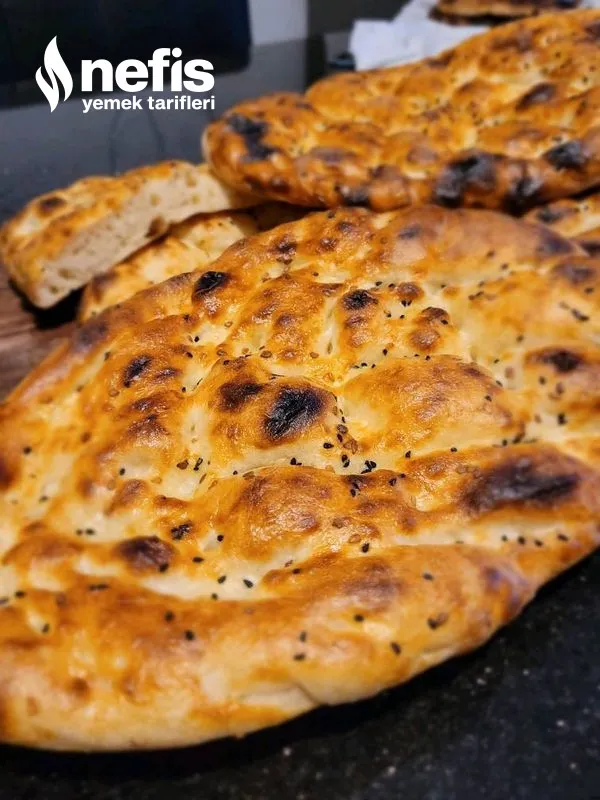Imagine sinking your teeth into a warm, freshly baked bread that transports you straight to the heart of Turkey with every bite. Eki Mayal Ekmek, a traditional Turkish bread, is not just a recipe—it's a culinary journey that combines simple ingredients with centuries-old baking techniques. Whether you're a passionate home baker or a curious food lover, this recipe promises to elevate your bread-making skills and bring an authentic taste of Turkish cuisine right to your kitchen.
Prep Time: 20 mins
Cook Time: 30 mins
Total Time: 50 mins
Cuisine: Turkish
Serves: 4 servings
Ingredients
- 500g flour
- 300ml water
- 10g yeast
- 1 teaspoon salt
- 1 tablespoon sugar
- 2 tablespoons olive oil
Instructions
- In a large mixing bowl, combine the flour and salt. Mix them together thoroughly to ensure an even distribution of the salt throughout the flour.
- In a separate bowl, dissolve the yeast and sugar in warm water (approximately 37°C or 98°F). Allow the mixture to sit for about 5-10 minutes until it becomes frothy, indicating that the yeast is active.
- Once the yeast mixture is frothy, add it to the flour mixture along with the olive oil. Stir with a wooden spoon or your hands until the ingredients start to come together.
- Transfer the dough to a lightly floured surface and knead it for about 10 minutes, or until it becomes smooth and elastic. If the dough is too sticky, sprinkle a little more flour as needed.
- Form the kneaded dough into a ball and place it in a lightly oiled bowl, turning the dough to coat it with oil. Cover the bowl with a clean kitchen towel or plastic wrap.
- Let the dough rise in a warm place for about 20-30 minutes, or until it has doubled in size.
- Once the dough has risen, punch it down to release the air. Divide the dough into four equal portions and shape each portion into a ball.
- On a lightly floured surface, roll out each ball of dough into a flat oval or round shape, about 1 cm thick. You can adjust the thickness according to your preference.
- Preheat your oven to 220°C (428°F). If you have a baking stone, place it in the oven to heat up as well.
- Transfer the rolled-out dough onto a baking sheet lined with parchment paper or directly onto the preheated baking stone. If desired, you can create a slight border around the edges to hold in toppings.
- Optionally, brush the surface of the dough with olive oil and sprinkle with your choice of toppings such as sesame seeds, herbs, or cheese.
- Bake in the preheated oven for about 10-15 minutes, or until the bread is golden brown and cooked through. Keep an eye on it to avoid over-baking.
- Once baked, remove the bread from the oven and let it cool slightly on a wire rack. Serve warm with your favorite dips or as a side to your main dishes.
Tips
- Temperature is Key: Ensure your water is lukewarm (around 37°C) when activating the yeast. Too hot, and you'll kill the yeast; too cold, and it won't activate properly.
- Kneading Technique: Don't rush the kneading process. A full 10 minutes of kneading develops the gluten, giving your bread its signature soft and elastic texture.
- Rising Environment: Choose a warm, draft-free spot for your dough to rise. A turned-off oven with the light on or near a sunny window works perfectly.
- Baking Surface: If possible, use a baking stone or a preheated cast-iron skillet to achieve a crispy bottom and even baking.
- Customization: Feel free to experiment with toppings like nigella seeds, za'atar, or sprinkled cheese to make the bread uniquely yours.
- Storage Tip: If you have leftovers, store the bread in an airtight container and warm it slightly before serving to restore its fresh-baked texture.
Nutrition Facts
Calories: 250kcal
Carbohydrates: 45g
Protein: 7g
Fat: 5g
Saturated Fat: 1g
Cholesterol: 0mg


